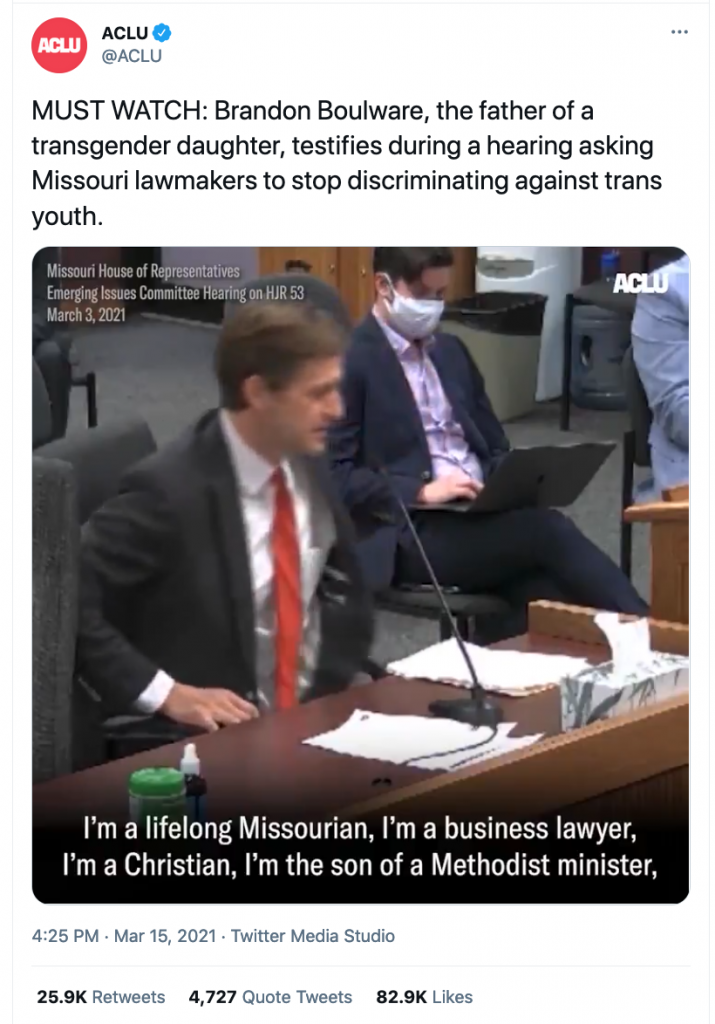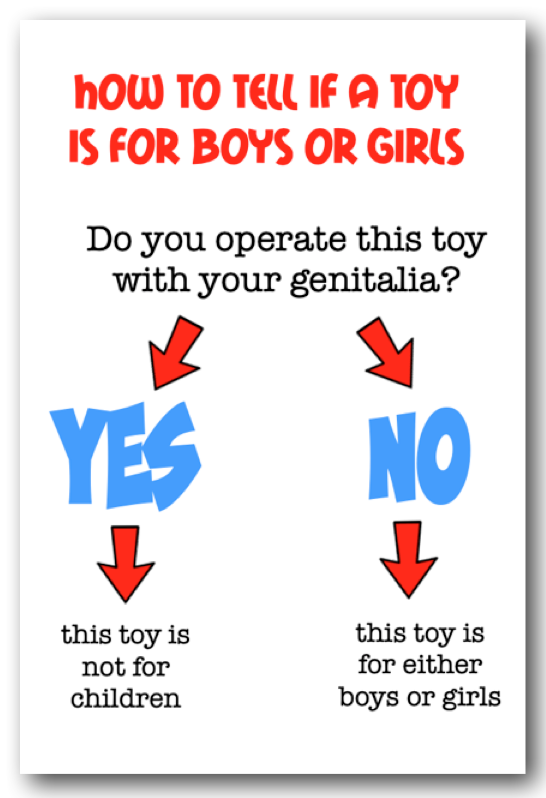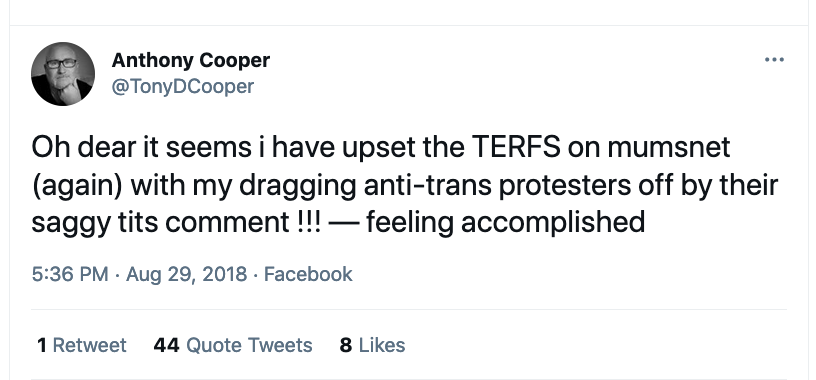 A clip posted by the American Civil Liberties Union (ACLU) on Twitter a couple of days ago has been shared all over the world on various social media platforms, reaching millions of viewers and provoking diverse reactions in those who view it. The clip is of father Brandon Bouleware, lawyer and self-described ‘Christian son of a Methodist minister’, addressing the Missouri House of Representatives on March 3rd, 2021.
A clip posted by the American Civil Liberties Union (ACLU) on Twitter a couple of days ago has been shared all over the world on various social media platforms, reaching millions of viewers and provoking diverse reactions in those who view it. The clip is of father Brandon Bouleware, lawyer and self-described ‘Christian son of a Methodist minister’, addressing the Missouri House of Representatives on March 3rd, 2021.
 House Joint Resolution 53, if passed, Bouleware tells the House, “will have real effect on real people. It will affect my daughter. It will mean she cannot play on the girls’ volleyball team, or dance squad or tennis team.” Bouleware’s voice breaks slightly as he begs,“I ask you, please don’t take that away from my daughter.”
House Joint Resolution 53, if passed, Bouleware tells the House, “will have real effect on real people. It will affect my daughter. It will mean she cannot play on the girls’ volleyball team, or dance squad or tennis team.” Bouleware’s voice breaks slightly as he begs,“I ask you, please don’t take that away from my daughter.”
Bouleware clearly cares about his child. He has travelled to the House of Representatives to fight her corner. We don’t know how old Bouleware’s daughter is, but we do know one significant thing: Bouleware’s daughter is a boy.
Bouleware is calling on lawmakers to reject House Joint Resolution 53 which would write into the Missouri state constitution that boys could not play on girls’ sports or athletics teams, even if they identify as girls. Missouri is one of 20 US states considering taking such action after Mississipi passed such a bill earlier this month.
 “US father pleads against bill that would ban trans daughter’s right to play sport” reports the Guardian, but this isn’t entirely true, is it? Bouleware’s child is not being ‘banned from sport’, it’s just being suggested that he shouldn’t be allowed to play on the girls’ team.
“US father pleads against bill that would ban trans daughter’s right to play sport” reports the Guardian, but this isn’t entirely true, is it? Bouleware’s child is not being ‘banned from sport’, it’s just being suggested that he shouldn’t be allowed to play on the girls’ team.
The child may really, really, really want to play on the girls’ team and yes, when your kid really wants something and they can’t have it it breaks your heart, but there is more than the feelings of one child to consider here.
Because this child is not a girl.
Who gets to play
There are lots of different criteria which decide who can play on a sports team. A Missouri child cannot, for example, play on an Illinois team, because they are not from Illinois. A child without mobility issues cannot play on a team for kids in wheelchairs, because they have full use of their legs. A seven year old cannot play on an Over 11s team, because they are too young. And a boy should not be allowed to play on a girls’ team, because he is not a girl.
Allowing this to happen will indeed have “a real effect on real people”. Those people are girls: because once you let boys on the girls’ team, it isn’t a girls’ team any more. Once you tell girls that a boy can be a girl, the word girl doesn’t mean much anymore.
How can we understand that the other scenarios above are unreasonable and yet be so blinkered on this issue? How does a culture reach a point where its sexism is so ingrained that it is willing to call a boy a girl and a girl a boy and pat itself on the back for doing so?
Despite our current protestations to the contrary, our culture remains both sexist and homophobic. There are still restrictive rules concerning how boys and girls should behave and woe betide those who break them. In pre-pubescent children, as far as appearances go, these rules are more obviously restrictive for boys. A girl who likes jeans and football may well be called a tomboy; but this is often said with a grudging admiration and the presumption that she will ‘grow out of it’. So we often hear women say, “I used to be such a tomboy as a child!” but rarely will a man declare to his peers,”I used to be such a sissy!” because society deems it shameful. A boy who wants to break the rules, who wants long hair, who cries easily and loves sparkles and all things pink will be judged and found lacking by a culture that expects men and boys to perform masculinity at all times.
Bouleware tells the house about his response to his son’s wish to break these rules.
“For years, I would not let my daughter wear girl clothes. I did not let her play with girl toys. I forced my daughter to wear boy clothes and get short haircuts; play on boy sports teams.”
Bouleware goes on to explain.
“Why did I do this? To protect my child. I did not want my daughter or her siblings to get teased…”
Nobody wants their kids to be teased or bullied. A boy who likes to wear dresses and play with dolls is an easy target; it’s a sturdy soul indeed that can make light of such teasing. No wonder Bouleware was concerned for his son. While some boys may turn back to the Barbie Princess castle with a shrug, for many even casual jibes can be shattering.
 So Brandon, like many in America’s ‘bible belt’, holds very strict ideas about what constitute ‘girls’ toys and ‘girls’ clothes.
So Brandon, like many in America’s ‘bible belt’, holds very strict ideas about what constitute ‘girls’ toys and ‘girls’ clothes.
There is a certain standard of manliness that even the smallest boys are held up to, and in Brandon’s eyes his son falls far short. And he, with his Methodist upbringing, is well aware of this, adding:
“ Truth be told I did it to protect myself as well. I wanted to avoid those inevitable questions as to while my child did not look and act like a boy…”
It was hard for Bouleware to accept that his son was not successfully playing the boy role and it is honest of him to admit that. We can imagine that he was embarrassed; that he was worried about what friends and neighbours might think; the people at church; perhaps he felt his child’s effeminacy reflected badly on his own manhood and his parenting skills. Social pressures mean it isn’t always easy for parents to feel relaxed if their children break the unwritten rules surrounding gender.
A different child
After years of forcing his son to perform masculinity, Bouleware had a revelation, that “as a parent, the one thing we cannot do is silence our child’s spirit.”
Brandon now believes that his son’s behaviour can be explained by the fact that he has a girl’s spirit inhabiting his boy’s body. Once he comes to this conclusion, the boy is allowed to wear the ‘girl’ clothes and play with the ‘girl’ toys.
“On the day my wife and I stopped silencing our child’s spirit, the moment we allowed her to grow her hair, wear the clothes she wanted to wear, she was a different child. It was immediate. It was a total transformation. I now have a confident, smiling, happy daughter.”
This is how you maintain your beliefs about gender roles when confronted with a child that doesn’t want to play by the rules of the gender game; this is how Bouleware believes he can best protect his son and let him wear those clothes and play with those toys. The boy is really a girl. The boy has to become, as Brandon says above, a different child.
The boy need no longer be an anomaly, an effeminate embarrassment: he can become the ‘wonderful and beautiful transgender daughter’ that Bouleware now tells the world he has.
“I need you to understand… let them have their childhoods; let them be who they are,” he pleads, with no sense of irony.
Letting a children truly ‘be who they are’ during childhood would involve letting them make all their own choices about clothing, hair and hobbies. In all but the most radical of radical unschooling families there will be limits imposed on these choices- but an adult who will only allow a child to pursue the hobbies and clothing that they think appropriate for the the child’s sex is an adult who is sexist.
The uncomfortable question we have to ask is why can his culture- our culture- not tolerate long-haired, dress-wearing little boys? The answer is a mixture of sexism and homophobia.
Sexism
 Sexism puts restrictions on what men and boys can and should do and what women and girls can and should do.
Sexism puts restrictions on what men and boys can and should do and what women and girls can and should do.
Sexism is everywhere. Sexism says that little boys shouldn’t wear dresses and little girls shouldn’t collect bugs. Some parents have incredible difficultly dealing with kids that don’t play by the rules.
In her 2015 article, ‘My Child Is Transgender: This Is How I Know‘, Alex Bliss writes that buying her daughter clothes in the boys’ section felt ‘felt deceitful, wrong, like a lie’.
Once a psychologist offered a disagnosis (after a 20 minute session) the girl’s parents ‘start allowing him (sic) to do boy things’.
“The signs had started in the womb when I’d been convinced I was carrying a boy.” writes Bliss of her daughter, who now ‘lives as a boy’. “The signs were in the loud burps he emitted at will, and the farting sounds he and his friends launched from their armpits.”
Sexism says hearts are for girls and farts are for boys.
Amber Briggle’s daughter Max, “has always identified as a boy.” How does she know? Max told her when she was two with the words, ‘Mom, I’m not a girl, I’m a boy, and I like Spider-Man.’

There was a while there in the late 80s and 90s where we were coming to an agreement on the fact that sexism was A Bad Thing. And then the gender boom happened.
Sexism is inextricably entwined with gender roles and gender. The au courant idea of gender identity links a child to a specific group of behaviours which define their sex. The idea of gender identity, by its very nature, is sexist.
Children’s brains are a wonderful kaleidoscope of elements which form millions of distinct personalities. It is not surprising when a child who is raised to believe that ‘boy clothes’ or ‘girl clothes’ are what define their sex begins to question if their personality has been somehow misplaced.
Bouleware had an effeminate son who might have grown up to be gay. Now he has an acceptable, ‘beautiful’, straight daughter. God be praised.
Homophobia
We can’t presume that effeminate little boys and rugged little girls will grow up to be gay and lesbian adults, although it is often the case, and the outcome is more likely for boys than for girls. So how likely is this? Looking at a couple of studies done before the current fad of transitioning pre-pubescent children we can see that it’s fairly likely.
Sex researcher Richard Green’s 1986 study of ‘extreme cases of boyhood effeminacy’ showed that 75% of 44 extremely feminine boys matured as homosexuals or bisexuals. Just one of the boys grew up to be transsexual. A Kinsey Institute survey of 1,500 adults singled out gender nonconformity in childhood as the most important predictor of homosexuality.
Researcher J Michael Bailey agreed with this view a decade later in 1995, as reported in the Associated Press.
“If you have a very feminine boy, one so feminine that he’s constantly wanting to dress up as a girl and wants to be a girl, chances are he’s going to be a gay man,″ reported Bailey, then a psychologist at Northwestern University. “The chance is probably about 75% for these boys.”
We- I use ‘we’ here to refer to what is commonly called ‘Western culture’ – now agree with confused, vulnerable, sensitive boys that yes, they’re girls. We do this despite knowing that social transition is highly likely to lead to puberty blockers and we know that puberty blockers almost inevitably lead to cross sex hormones and we know that the combination of the two leads to sterility and loss of sexual function.
We live in a culture that would rather sterilise little boys and make them lifelong medical patients than challenge the morality of imposing gendered behaviours on children.
Without irony, we call those who opposite child transition right-wing fascists and bigots.
We do this because our culture resents and reviles effeminate men. It is repulsed by girlish boys because it sees effeminacy as inextricably linked with homosexuality and homosexuality as an undesirable outcome, allied to the weakness and inferiority that our culture associates with all things female. Western culture cannot bring itself to gently insist to these boys that it’s ok to be a gentle, sensitive boy. Better that we pretend they are girls.
So we refer to them as girls, we dress them in the trappings of femininity; we block their puberty so they can continue to look like pre-pubescent girls, and when they are older we operate on their bodies so they superficially resemble adult women. We tell ourselves that transitioning children is progressive and inclusive, but it is neither.
As for lesbians, ‘we’ don’t much like them either. Even many young lesbians choose to describe themselves as ‘gay’ or ‘queer’ rather than own the word.
 Remember ‘trans ally’ Anthony Cooper, the compère of Manchester Pride who suggested that lesbian protestors should be ‘dragged off by their saggy tits’?
Remember ‘trans ally’ Anthony Cooper, the compère of Manchester Pride who suggested that lesbian protestors should be ‘dragged off by their saggy tits’?
The LGBTQIA2+ movement may still have the L at the front of the acronym, but if lesbians want to be listened to and included, they’d better be willing to say that men can come under their banner.
Lesbian representation on television is limited: lesbian characters perform femininity, they wear make-up and high heels. They probably get killed off around the end of season one so the bi girl can go back to her boyfriend.
There is a deep homophobia in our culture and there is a deep homophobia behind transactivism.
 It raises its head when transactivist Fox Fisher says, “It doesn’t help to have the T latched on to LGB because… it muddies the waters a bit because people start to think it’s a deviant kind of thing.”
It raises its head when transactivist Fox Fisher says, “It doesn’t help to have the T latched on to LGB because… it muddies the waters a bit because people start to think it’s a deviant kind of thing.”
Back on the ACLU post on Twitter, the comments come in thick and fast. Brandon’s video has received another 3k ‘likes’ in the 24 hours since I started writing this piece. Many of those horrified by the ACUL clip point out that Brandon’s child would probably have grown up to be a gay man if left undisturbed. Others disagree.
“I have an adult trans daughter – her sexual attraction is to women – how honestly difficult is it to understand that our gender identity has nothing whatsoever to do with our sexuality?”
I stared at this tweet for a while, trying to work out what his point was. Whatever it was, it certain was difficult to understand. Did he have a son who was his daughter? Or a daughter who was his son? Convention suggests that ‘trans daughter’ would refer to a male-bodied person. But if he believed his male daughter to be a woman who was attracted to women then surely that would mean he saw his daughter as a lesbian? But then if he knew that his daughter was really a man, then he would perceive his daughter as straight. As the point he was trying to make was ‘trans people are not necessarily gay’ then why would he use the example of his ostensibly lesbian trans-daughter?
My head is spinning.
‘He’s not pretending he’s a girl he is a girl!” retorted another Twitter user. The words, ‘he is a girl’ suggests they know very well that this boy isn’t a girl – otherwise why would they refer to him as ‘he’? Or her. Her as he.
See how ridiculous it all gets when we can’t name sex?
Conversion therapy
Converting your effeminate little boy into a girl, denying his sex so he better fits society’s narrow views of how boys and girls should behave- surely that is the ultimate in conversion therapy?
Fiercely protecting the rights of both boys and girls to play with the toys they like and wear the clothes they choose – when did that become hateful right-wing bigotry?
Meanwhile, back in the bible belt, as the world continues to be gaslit into believing that transitioning children is enlightened and wonderful, a little boy who loves dresses is finally allowed to express himself.
But at what cost?


While I definitely concur with the base assertion I think there is a serious possibility Munchhausen’s by Proxy is present in a significant number of parents (mothers) of these trans children. Especially the publicly visible ones – I won’t mention the names, although that’s really not necessary, is it…
The really strange thing is that gay acceptance seems to have achieved effective saturation, at least in the Western world. Gay people’s own movement has turned on them – not nasty bigots or old fashioned religious types.